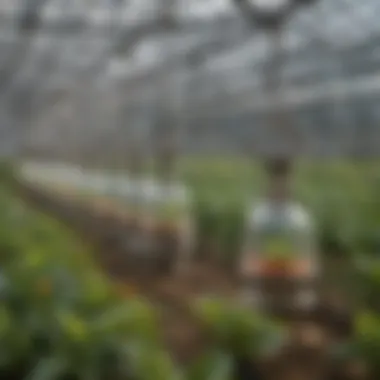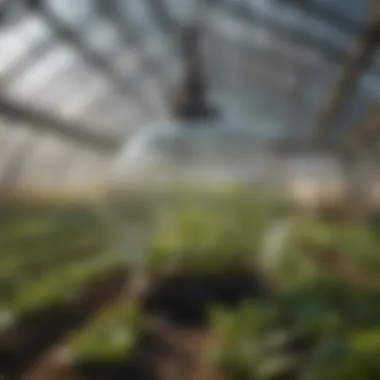Exploring Greenhouse Actuators: Types and Trends


Intro
Greenhouses have progressed remarkably in recent years, serving as a beacon of sustainable agriculture. Among the pivotal elements that enhance their operational efficiency are greenhouse actuators. These devices are not just mechanical marvels; they streamline processes that are integral to modern farming. As farmers and agronomy enthusiasts increasingly turn to technology to improve yields and reduce labor costs, understanding the mechanisms and applications of these actuators becomes essential.
This article aims to illuminate the variety of greenhouse actuators, with particular focus on their functionalities and the role they play in fostering optimal growing conditions. By exploring both current applications and potential future innovations, it seeks to provide an all-encompassing guide for those interested in agricultural developments and best practices.
Prolusion to Greenhouse Actuators
Greenhouse actuators play a pivotal role in modern agriculture, shaping the way we cultivate crops in controlled environments. Understanding these mechanisms is not just about knowing their functions; it's essential for optimizing greenhouse operations and ensuring plant health. As climate change continues to pose challenges to traditional farming practices, the need for reliable and efficient greenhouse systems has never been more crucial. Thus, a comprehensive grasp of greenhouse actuators enables farmers and professionals to enhance productivity, harness sustainable practices, and adapt to the evolving agricultural landscape.
Definition and Importance
At its core, a greenhouse actuator is a device that manages physical change—whether that involves controlling vents, adjusting curtains, or even regulating irrigation systems. These automation tools serve a fundamental purpose: to create optimal conditions for plant growth by regulating temperature, humidity, and light exposure. The significance of these devices lies not only in their technical function but also in their broader impact on agricultural efficiency.
Effective actuators lead to substantial benefits:
- Enhanced Plant Growth: Proper ventilation ensures that plants receive the right conditions for photosynthesis and transpiration, promoting healthy growth.
- Resource Optimization: Automating tasks reduces water consumption and energy usage, conserving valuable resources.
- Labor Efficiency: By automating repetitive tasks, these devices free up labor, allowing farmers to focus on more critical aspects of cultivation.
- Consistent Quality: In regulated environments, crops tend to grow more uniformly, yielding higher-quality produce.
As such, their importance extends beyond mere functionality; they are key contributors to sustainable agricultural practices.
Historical Overview
The journey of greenhouse actuators mirrors the evolution of agricultural technology, intertwined with advancements in engineering and environmental science. Traditionally, manual systems governed greenhouse operations, demanding physical intervention to adjust environmental conditions. This era relied heavily on human labor and natural fluctuations to guide agricultural practices.
However, with time, various innovations surfaced. In the mid-20th century, the advent of mechanical systems marked a turning point. Early actuators were rudimentary but paved the way for more efficient designs. By the late 20th century, advancements in materials and manufacturing allowed for the development of pneumatic and hydraulic actuators, which offered enhanced control over environmental conditions. As technology progressed, digital control systems emerged, leading to increasing sophistication in greenhouse automation.
Today, we stand at the brink of the next stage in actuator technology. With the integration of smart technology and IoT capabilities, control systems are becoming more intuitive, allowing for real-time adjustments based on changing conditions. This historical perspective underscores the fact that greenhouse actuators are not only practical tools but also symbols of the relentless push towards innovation and efficiency in agriculture.
Types of Greenhouse Actuators
The landscape of greenhouse automation is significantly shaped by the various types of actuators available. Each type has its own unique attributes, functioning mechanisms, and advantages tailored to different agricultural needs. Understanding these types helps farmers and enthusiasts optimize their greenhouse environments for growth and productivity. Here’s a breakdown of the four main types of greenhouse actuators: mechanical, pneumatic, electric, and hydraulic.
Mechanical Actuators
Mechanical actuators rely on physical systems to generate movement. They generally operate through gears, levers, or screws, translating a simple motion into a more complex one. A common example would be a manual hand crank that opens or closes ventilation windows. While mechanical actuators are often seen as more traditional, they carry certain benefits:
- Cost-effective: Mechanical systems are typically less expensive to produce and install than their more tech-savvy counterparts.
- Simplicity: The straightforward design leads to ease of use, maintenance, and repairs, making them a suitable choice for small-scale operations.
- Reliability: With fewer electronic components, they tend to have fewer points of failure, increasing their longevity.
However, the manual nature of mechanical actuators means they often require more human intervention, which can be a drawback in high-demand environments.
Pneumatic Actuators
Pneumatic actuators utilize compressed air to create motion. This type is growing in popularity due to its ability to produce rapid and strong movements without much physical energy. Here are a few key points:
- Speed: Pneumatic systems can actuate more quickly than mechanical ones, which is vital in rapidly changing climate conditions.
- Clean Operation: With no oil or grease, pneumatic actuators are environment-friendly, making them a good choice for organic farming.
- Force: They can exert more force in applications such as opening heavy doors or moving large structures.
However, it’s crucial to consider that these systems can be complex, requiring careful maintenance and a consistent supply of compressed air.


Electric Actuators
Electric actuators are powered by electrical energy, making them a modern favorite among greenhouse operators looking to automate various processes. They are particularly valued for their precision and control:
- Automation: They can easily integrate into automated control systems, allowing for smart agriculture approaches.
- Precision: Electric actuators provide accurate positioning and control, which is essential for tasks like adjusting light shades or vents.
- Low Operating Costs: Compared to hydraulic systems, electric options often incur lower operational costs over time.
Despite these advantages, electric actuators might require a constant electrical supply, making them less ideal for remote areas without reliable electricity.
Hydraulic Actuators
Hydraulic actuators use pressurized fluid to create movement, a method valued for its powerful and smooth operation. Here are the primary benefits:
- Strength: They can handle heavy loads effortlessly, which is a plus for bigger greenhouses needing to open large structures with little effort.
- Versatility: Hydraulic actuators can be configured for various applications, from opening roofs to controlling large ventilation systems.
- Smooth Operation: The fluid dynamics allow for a smoother actuation compared to mechanical systems.
However, they can be more expensive to install and maintain. Moreover, leakage or maintenance issues with hydraulic fluid could potentially harm the environment in a greenhouse setting.
How Greenhouse Actuators Operate
Understanding how greenhouse actuators operate is crucial for harnessing their full potential in agricultural settings. These devices form the backbone of effective greenhouse management, allowing farmers to automate various processes that directly impact plant health and productivity. From controlling temperature to regulating humidity, their functionality makes them an indispensable tool. Furthermore, knowing the intricacies of their operation can aid in troubleshooting, enhancing efficiency, and ultimately increasing crop yield.
The Mechanisms Behind Actuation
At the core of greenhouse actuators are several mechanical and electronic systems that convert energy into movement. The primary types of mechanisms include:
- Rotary Actuators: These provide circular motion and are integral in tasks such as adjusting vents or turning blinds.
- Linear Actuators: Designed for straight-line motion, they're often used for sliding doors or windows. Their precision makes them ideal for sensitive tasks like opening and closing vents without excessive force.
Technically, actuators rely on various energy sources—electrical, pneumatic, or hydraulic—each with its set of pros and cons. For instance, electric actuators are favored for their easy integration with automation systems, while hydraulic actuators offer greater force and can handle heavier loads.
A crucial aspect is the feedback system that allows actuators to react in real time to changing environmental conditions. This mechanism ensures adjustments are made promptly, enhancing plant growth and reducing resource waste.
Control Systems and Automation
Automation in greenhouse actuators serves as a leap towards increased efficiency. Let's break this down further:
Manual Control Systems
Manual control systems are straightforward, allowing users to operate actuators through switches or remotes. They offer simplicity and direct control, enabling farmers to react instantly to immediate conditions. A notable characteristic of manual systems is that they are cost-effective and easy to implement, making them an attractive choice for small-scale agricultural setups. However, the unique feature lies in their hands-on operation, which can become laborious over time. Also, they lack the adaptability of automated systems, especially in dynamic environments where conditions may change rapidly.
Automated Control Systems
On the other hand, automated control systems transform greenhouse operations. These systems employ sensors and timers to adjust actuators without human intervention. Key benefits include:
- Increased consistency in operation, which is crucial for maintaining optimal growing conditions.
- Energy efficiency as these systems only run when necessary.
One unique aspect of automated control systems is their ability to adapt to preset conditions based on data input from various sensors. Despite their advantages, they can often present a challenge in terms of initial setup costs and ongoing maintenance requirements. A technical glitch can lead to significant issues if the system fails to react appropriately.
Integration with Smart Technology
Modern advancements have seen a rise in the integration of actuators with smart technology. This includes connectivity with smartphones or centralized control systems. The key characteristic of this integration is the ability to monitor and control systems remotely through applications. This offers remarkable benefits, such as:


- Real-time data analysis of greenhouse conditions.
- Improved decision-making based on data trends.
A unique feature of this technology is its user-friendly interface, which simplifies complex tasks. However, challenges such as reliance on stable internet connectivity can affect functionality. Additionally, the security of data transfers raises concerns, necessitating robust cybersecurity measures for operational integrity.
By understanding the mechanisms and control systems at play, agricultural professionals can not only enhance their current practices but also prepare for future advancements in technology, ensuring continued growth and sustainability in their operations.
Applications of Greenhouse Actuators
The practical usage of greenhouse actuators stands as a testament to their indispensable role in modern agriculture. Beyond just functionality, these actuators enhance the efficiency and productivity of greenhouse environments, contributing to the overall goal of maximizing yields through precise control of various elements. Engaging with the intricacies of these devices highlights how they shape agricultural practices today and in the future.
Climate Regulation
Control over climate is pivotal in greenhouses where external conditions can undermine the conservation of favorable environments for plant growth. Greenhouse actuators help to fine-tune temperature, humidity, and light exposure. By adjusting windows, shades, and heaters autonomously, they mitigate the risks of temperature fluctuations that could jeopardize crop quality.
For instance, consider the case of a greenhouse managed in regions with abrupt weather changes. Here, humidity levels can change drastically, leading to either excessive condensation or aridity. Using actuators for real-time monitoring allows growers to modify internal climate conditions promptly, greatly reducing plant stress.
Ventilation Management
Proper ventilation plays a crucial role in maintaining the health of plants by regulating air circulation and preventing the buildup of heat and humidity. Here, actuators come into play by opening and closing vents based on sensory feedback from the greenhouse environment.
Imagine greenhouses brimming with sensitive plants; without adequate air exchange, they could quickly succumb to diseases. Actuators react to internal climate indicators, ensuring that fresh air flows into the greenhouse when it’s most vital. This proactive management not only supports plant health but also contributes to energy efficiency, reducing the need for mechanical cooling.
Irrigation Control
Water management is another area where greenhouse actuators shine. They offer automated solutions for irrigation systems that are crucial for optimal plant growth. Through precise scheduling and monitoring of soil moisture, actuators help deliver water when it is most needed, reducing wastage and ensuring that plants receive tailored hydration.
In regions susceptible to drought, this precise approach can mean the difference between a thriving crop and one that struggles. Furthermore, by employing sensors with actuators, growers can transition to variable-rate irrigation practices that adjust water supplies according to specific crop needs, ultimately leading to healthier plants and better resource utilization.
Integration in Hydroponics
Hydroponics systems, which rely on nutrient-rich water rather than soil, also benefit significantly from greenhouse actuators. Here, the integration of actuators helps in automating the nutrient delivery process, environmental control, and light exposure adjustments, all of which are critical to maintaining an ideal growth medium.
For example, in a fully automated hydroponics setup, actuators can supply nutrients at precise intervals based on real-time analytics, ensuring that each plant receives its required sustenance without manual intervention. This level of automation not only boosts efficiency but also enhances consistency, allowing farmers to scale operations effortlessly.
Each of these applications paints a comprehensive picture of how greenhouse actuators contribute to the holistic agricultural ecosystem. Through effective climate regulation, ventilation management, precise irrigation control, and seamless integration into hydroponics, growers can optimize their resources and yield healthier crops. The ongoing evolution of these technologies promises even greater impacts on efficiency and sustainability in the agricultural landscape.
Challenges in Using Greenhouse Actuators
While greenhouse actuators play a pivotal role in optimizing agricultural practices, they do not come without their hurdles. Various challenges arise, which can deter efficiency and complicate implementation. Recognizing these issues is essential for anyone looking to maximize the benefits of these technologies.
Cost Considerations
The cost of greenhouse actuators can be a sticking point for many farmers. Depending on the type—be it mechanical, electric, or hydraulic—the initial investment can be quite hefty. For instance, electric actuators, while often more efficient and easier to automate, may require a larger upfront capital compared to simpler mechanical options. Additionally, there are operational expenses to consider, such as electricity usage or system repairs over time.
- Initial Investment: Assessing which actuator suits the budget while meeting functionality needs is key.
- Long-term Savings vs Short-term Costs: Investing in advanced automation may save money in labor costs but can strain the wallet initially.
- Funding and Grants: Many governments offer subsidies, which help ease some financial burdens. Researching such options can mitigate costs.
Technical Limitations
Technical challenges with actuators can also pose significant problems. One major concern is compatibility with existing systems. Older greenhouse designs may not accommodate modern actuators without significant modifications. Furthermore, the reliance on technology comes with its own set of complications; software glitches or mechanical failures can lead to downtime, which is particularly detrimental during critical growing periods.


- Compatibility Issues: Ensuring that new equipment integrates smoothly with older systems is crucial for farmers not ready to overhaul their entire setup.
- Sustainability of Technology: As technology evolves, earlier models might become obsolete, prompting additional investments sooner than anticipated.
- Training and Expertise: There’s often a learning curve associated with new systems, necessitating time and resources to train personnel properly.
Maintenance Challenges
Maintenance emerges as a common concern for greenhouse actuators. Regular upkeep is crucial to ensure they operate flawlessly, but the complexity of some systems can make this task daunting. Farmers may find themselves wrestling with intricate mechanisms that require specialized knowledge, leading to reliance on external technicians and further expenses.
- Regular Maintenance Needs: Staying on top of maintenance schedules is vital to prevent costly repairs or replacements down the road.
- Expert Assistance: Some systems may require technicians to manage repairs, adding to labor costs.
- Parts Availability: Replacement parts might not always be easy to source, leading to potential downtime and frustration.
"Proper maintenance is just as critical as the initial setup; one won't compensate for the other."
In summary, when considering greenhouse actuators, one must not overlook these challenges. By understanding the cost implications, navigating technical limitations, and addressing maintenance needs, farmers can better strategize their implementations. This awareness aids in choosing the right actuators that not only enhance productivity but also contribute to the sustainability of their operations.
Future Directions in Actuator Technology
The realm of actuator technology is rapidly evolving, offering innovative solutions that can significantly enhance the efficiency and effectiveness of greenhouse operations. As agricultural practices adapt to meet the challenges of climate change, population growth, and resource limitations, understanding the future directions in actuator technology becomes paramount. This section explores how advancements in materials, automation, and sustainability practices are shaping the next generation of greenhouse actuators.
Innovative Materials and Designs
The use of innovative materials is crucial in the development of future actuator systems. Lightweight and durable materials can lead to more responsive and efficient actuators. For instance, composites such as carbon fiber or advanced polymers tend to offer superior strength-to-weight ratios compared to traditional metals. This can reduce the energy required for actuation while enhancing the overall lifespan of equipment in harsh greenhouse environments. Moreover, designs such as modular actuators make maintenance far simpler, allowing farmers to replace parts rather than overhauling entire systems.
Additionally, bio-inspired designs may become a growing trend. Nature often serves as the best teacher. Actuators mimicking the way plants open and close their leaves could enable more efficient light management within greenhouses, adapting to sunlight changes throughout the day with minimal energy consumption.
Advancements in Automation
Automation represents one of the most significant trends in the future of actuator technology. Automated systems, coupled with advanced sensors, allow for real-time adjustments in response to environmental changes. These systems can monitor temperature, humidity, and plant health, facilitating immediate responses that optimize conditions for growth.
For example, integrating IoT technology allows greenhouse owners to control actuators directly from their smartphones or computers. This level of connectivity not only saves time but also minimizes labor costs. It's a smart move for those looking to modernize their operations while retaining the ability to intervene manually when necessary.
Furthermore, machine learning algorithms can analyze vast amounts of data collected from these automated systems. Over time, they can enhance operational efficiencies by predicting the best times for irrigation, ventilation, and other necessary actions.
Sustainable Practices and Green Technologies
Sustainability continues to drive innovations in actuator technologies. The focus is not merely on efficiency, but also on reducing environmental impact. Future actuators can incorporate renewable energy sources, such as solar panels that power actuator operations, minimizing reliance on fossil fuels.
Implementing green technologies also includes using recyclable materials in actuator construction. This shift not only lowers the overall carbon footprint of the actuator itself but also promotes a circular economy within the agricultural sector. Harnessing eco-friendly practices can address many of the concerns highlighted by consumers regarding environmental stewardship.
"The future of agriculture lies in adopting sustainable technologies that enhance productivity while caring for our planet."
The End
In the contemporary landscape of agriculture, the relevance of greenhouse actuators has become increasingly pronounced. As agriculture takes on the dual challenge of producing more food while minimizing its environmental impact, the discussion surrounding these devices becomes essential. Greenhouse actuators play a vital role in streamlining operations, promoting efficient resource use, and enhancing plant growth in controlled environments. The combination of technology, sustainability, and innovative practices outlines the path forward for agronomy, ensuring that the agricultural community embraces modern solutions to age-old challenges.
Summary of Key Points
- Role of Actuators: Greenhouse actuators are key tools in managing internal environments effectively. They facilitate critical functions, such as climate regulation and irrigation control, ensuring optimal growth conditions for plants.
- Variety of Types: Understanding the various types of actuators—mechanical, pneumatic, electric, and hydraulic—equips farmers with knowledge to choose the most suitable systems for their specific needs and budget.
- Challenges and Solutions: While deploying these technologies comes with challenges, such as costs and maintenance, the benefits often outweigh these obstacles. Investing in solid systems can lead to long-term gains in productivity and crop quality.
- Innovation Ahead: The future of greenhouse actuators seems bright, characterized by advances in materials and automation. As sustainability becomes a pivotal consideration in agriculture, new technologies promise to further enhance greenhouse management efficiencies.
Call to Embrace Greenhouse Technologies
As we look to the future of agriculture, it is imperative for farmers and agricultural enthusiasts to adopt greenhouse technologies actively. The integration of advanced actuator systems not only boosts productivity but also aligns with sustainable practices that are increasingly demanded by consumers and regulations alike.
"Embracing these technologies is not just about keeping pace; it’s about leading the charge towards a more sustainable future in agriculture."
By leveraging greenhouse actuators, you can:
- Enhance Efficiency: Close monitoring and real-time adjustments lead to optimal growth conditions, boosting yields while reducing waste.
- Reduce Labor Costs: Automation minimizes the reliance on manual labor for routine tasks, freeing up time and resources for farmers to focus on strategic decisions.
- Pioneer Sustainable Practices: As the world shifts toward greener methodologies, adopting these innovations positions your operations as a trendsetter in sustainable agriculture.



